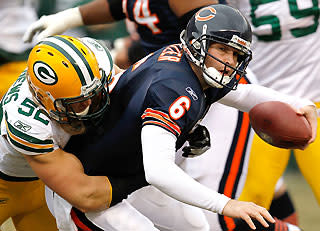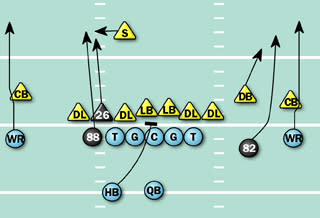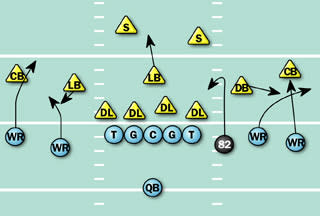Martz must utilize Bears' tight ends
Also in this article:
Next Surveillance:
Bills
More NFL:
Editor's note: Yahoo! Sports will examine the biggest weakness of the 2009 season for every team and explain how the franchise can address the issue. The series continues with the Bears, who finished third in the NFC North (7-9).
Biggest problem in 2009: Pass protection issues led to limited offensive options

Bears QB Jay Cutler(notes) was sacked 35 times in 2009.
(Jonathan Daniel/Getty Images)
By any measure, the Chicago Bears didn't get what they expected from the Jay Cutler trade in the first year with their new franchise quarterback. For the dear price of two first-round picks (one each in 2009 and 2010), a third-round pick in 2009 and quarterback Kyle Orton(notes), the Bears got a player (in addition to a 2009 fifth-rounder) who threw a league-high 26 interceptions (two rookies, Mark Sanchez(notes) and Matt Stafford, tied for second with 20), struggled with a less than spectacular receiver corps and regressed under the limited play-calling of offensive coordinator Ron Turner. Orton actually put up a higher passer rating in Denver (86.8 to Cutler's 76.8) and had a higher yards-per-attempt average despite Cutler's reputation as a great deep-ball thrower.
Of course, the fault wasn't Cutler's alone. Chicago's offensive line was a major problem in 2009, with Cutler constantly being under siege. He took 35 sacks, tied with Philly's Donovan McNabb(notes) for seventh-worst in the NFL, and many of his interceptions were the result of balky throws under pressure. According to Football Outsiders data, only the Redskins allowed more quarterback hurries than the Bears – Chicago quarterbacks were hurried 136 times in 563 attempts, and with 555 of those attempts, Cutler took the brunt of the attack. What has the team done to solve this problem? Not much. In fact, if the tendencies that have followed new offensive coordinator Mike Martz from his past destinations continue, Cutler could be in even worse trouble in 2010.
The 2010 solution: Overcome Martz's anti-tight end bias
There are two things we know about Martz's history as an offensive mastermind: His generally productive systems will eschew the tight end positions except for blocking purposes, and protection is the least of his concerns. Martz prefers seven-step drops with four- and five-wide receiver formations, which is a very dangerous combination unless you've got an all-star offensive line … which the Bears decidedly do not. Martz may have to adjust his concept of timing in the pocket, and tight end Greg Olsen(notes) could be the key to that turnaround.
In their Week 6 game against the Falcons last season, Chicago got a lesson in tight end usage from Tony Gonzalez(notes), Atlanta's future Hall of Famer, who lines up all over the field. In 2009, Gonzalez caught 83 passes and the Falcons ranked very highly in two- and three-tight sets in which Gonzo was essentially a big receiver split out into the slot or flex position. With two consecutive plays in the third quarter, the Bears showed that they had a few tricks up their collective sleeve with their tight end sets.

Figure 1
With 4:21 left in the third quarter and the Bears down 14-7, Chicago lined up on second-and-11 from the Atlanta 35-yard line in what looked like a three-receiver set, but this was actually two tight ends – Olsen (82) flexed out to the right and Desmond Clark(notes) (88) lined up tight against left tackle (fig. 1). Atlanta countered with a nickel-blitz look with safety Erik Coleman(notes) (26) covering Clark from the line. The outside receivers ran dual stutter-go routes, and Olsen cleared out the slot defensive back. Of course, the expectation would be for Cutler to throw to the flex TE, which is why the deep seam route to Clark on the other side was such an effective call. The play gained 24 yards and put the Bears in the red zone.

Figure 2
On the next play, Clark headed off the field, and the Bears went five wide with Olsen (82) inside a trips right (fig. 2). The clear-out route on that side split the two-man coverage and gave Olsen a perfect little zone pocket underneath for the quick comeback route. Cutler overthrew the easy pass (a common occurrence for him with short passes past year), but this call was the kind of one that Martz will have to consider if his playbook and Chicago's offensive personnel are to match up successfully. The Bears simply don't have the line or the receivers to make a go of a consistent deep passing game, but with quicker reads and route complexity, Martz and Cutler should be able to find a happy medium.
